Farming in the Desert
The new local culinary scene in America is about more than the great food trucks, farmers’ markets, and craft beer. We have seen inspired local food and agriculture efforts all over the country during our far-flung adventures for The Atlantic’s American Futures project, which is kicking off its new season this month.
Through the remainder of this election year, my husband Jim and I will be reporting on the way that issues so bitterly contested in the national election play themselves out city by city, family by family. This installment is about how the local food movement, often assumed to be one more feature of upscale urban life, is taking hold and changing prospects in a remote desert town with very modest financial resources, and with a long history of the health problems that arise from poor nutrition.
***
Ajo, Arizona, the small desert community we have visited several times and written about for American Futures, offers something unique: a thriving local agriculture and food movement in the middle of the Sonoran Desert. For starters, conditions are about as challenging as you can imagine: desert temperatures with freezes in the winter and 110 degrees in the summer; poor soil with low organic and microbial content, high alkalinity and caliche (a natural cement); and four inches of rainfall annually, often arriving in downpours.
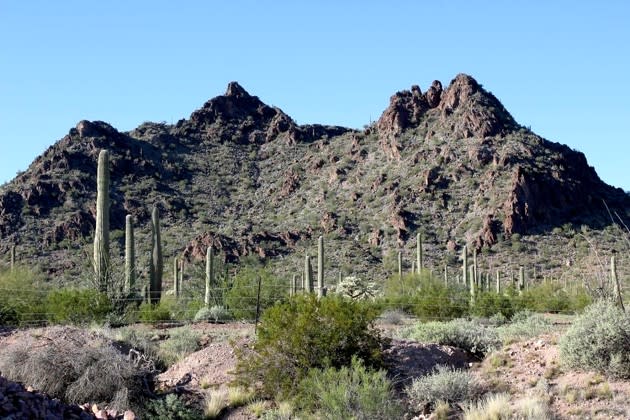
Undeterred, the active Ajo community pooled their energy and opportunities to build an intricate, cooperative network around food. Cooperating together in this town of only a few thousand people are the school, the clinic, local gardeners, the farmers’ market, local restaurants, the town’s grocery store, student interns, adult volunteers, the food bank, the CSA, and the anchor of the Sonoran Desert Conference Center, with its spaces for gardens, a chicken coop, celebratory events, teaching and demonstration space, and a newly-finished commercial kitchen. I think I have covered them all!
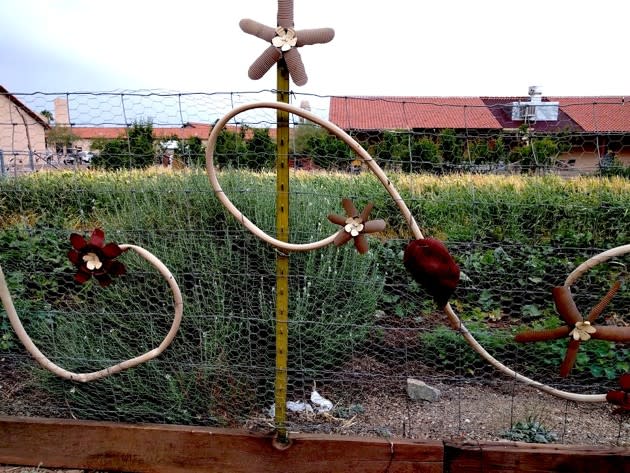
The Ajo Regional Food Partnership, established in 2009, pulls nearly all these efforts under its umbrella. One of the showpieces is the garden space at the Sonoran Desert Conference Center. We first visited the center in the winter of 2015, when crews were busy renovating the former classrooms of the former Ajo elementary school into rooms for overnight guests. The classrooms surround gardens in a central outdoor space. The gardens were also a work-in-progress when we first visited; a few were already producing a few rows of crops. The rest of the space remained hardscrabble dirt, and was impossible to imagine becoming fertile.
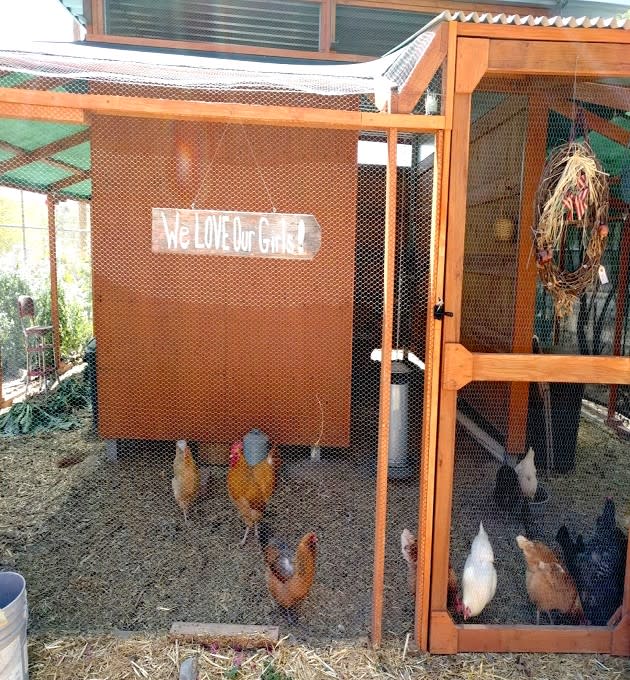
On our next visit, we stayed in one of the first newly-completed rooms, lonesome but promising. By our last visit, the center was bustling: Every room was occupied, hosting a spillover conference in Phoenix of grantees from Artplace America, a funding organization for locally-based artistic efforts. We ate communal meals assembled in the center’s new commercial kitchen, gathered around the evening campfire to talk and drink wine, watched a performance of Mexican dancing by little local kids, and kept a lookout for the nocturnal javelina to scuttle through the grounds. Roosters tried to wake us from their home by the chicken coops in the mornings.
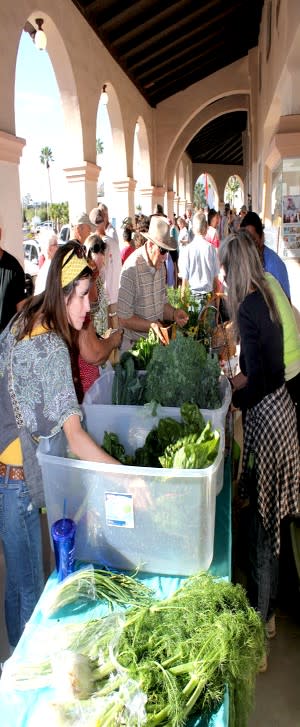
Volunteers were working in the gardens, and later in the week, assembling produce to sell at Saturday’s farmers’ market in the plaza. We stopped by on our way out of town, filling our bags with jalapeño bread, still hot and steamy from overnight ovens, marmalades from local citrus, and regrets that we couldn’t carry the fresh veggies or eggs. What began as mostly dabbler’s efforts in the market has matured to earning a living for a number of people.
I heard from several sources that the Saturday market is very popular among the kids of Ajo. A weekly class in the Edible Ajo Schoolyard is part of the curriculum for Pre-K through sixth graders. Come the weekend, they like to take their parents to the farmers’ market to point out and purchase some of the produce they grew and likely sampled in their school lunches already.
Recommended: Do We Need Zoos?
The Desert Senita Community Health Center in Ajo is a strong and active proponent of the food movement in Ajo (including being an early activist in the edible schoolyard), seeing it as a way to help many of their clientele learn about and improve their diets. The U.S. Department of Agriculture, in a report about Ajo, a grant recipient of its “Local Foods, Local Places” effort, describes in sobering terms: “The health of Ajo residents is a major concern for the community: high rates of diabetes, heart disease and obesity are present, and food insecurity—especially among children and the elderly—is prevalent.”
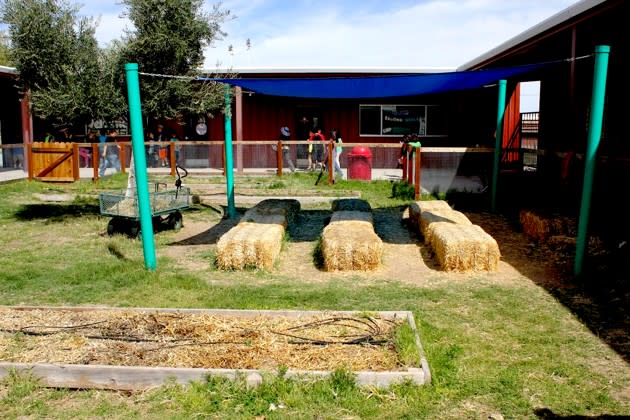
The center, which is Ajo’s clinic, counsels women on the WIC program (the federal Women, Infants, and Children program providing various benefits for those at nutritional risk) and SNAP (Supplemental Nutrition Assistance Program, commonly known as food stamps). The Ajo farmers’ market is now authorized to accept payments for both programs. And during our last visit, several people told me the exciting news that the “double-up bucks” program was granted to the market, meaning the value of the SNAP payments now buy twice as many fruits and veggies at the farmers’ market.
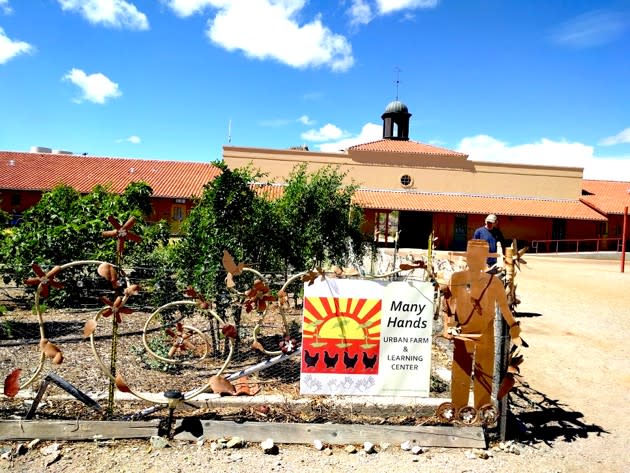
The Ajo Center for Sustainable Agriculture does its gardening and prep for the farmers’ market on the grounds of the conference center. The CSA was founded and has been run by Nina Sajovec, who describes herself as a community activist. She also described the serious and central role of food in her earlier life in Slovenia, centered around family, culture, and tradition. Now, Sajovec and her partner Sterling Johnson, who was born and raised on the nearby Tohono O’odham reservation, are expanding and managing the main gardens and the Many Hands Urban Farm and Learning Center, complete with chicken coops, which we also witnessed grow from an idea to a rustic Rolls Royce of chicken accommodations. One of the hallmarks of the CSA is to both learn from and return agricultural crops and practices to the reservation. The white pomegranate trees in the gardens of the CSA, for example, are a focus of indigenous farming in Ajo.
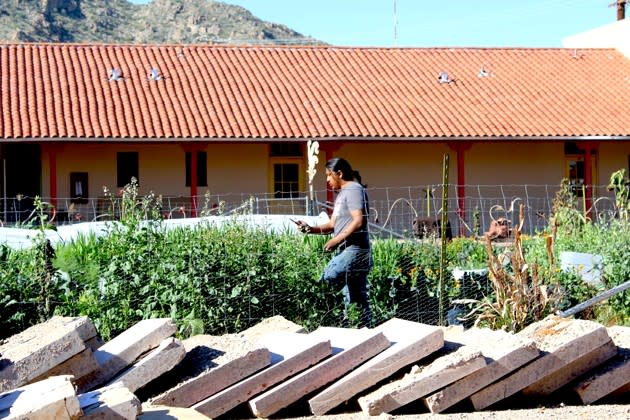
Sajovec described Ajo’s food bank distribution experience to me, as well. That week at the First Assembly of God church, somewhere between 120 and 150 cars lined up for occupants to receive bags of food. This week’s included potatoes, some broccoli heads, three or four loaves of white bread, some hamburger or hotdog buns, lots of citrus, and some sodas. Food bank workers passed the bags in through the car door windows. “It works better that way,” said Sajovec, because the experience is more anonymous for the recipients, who sometimes feel awkward. They want to make this experience dignified, she explained.
Recommended: Where Republicans Stand on Their Nominee: A Cheat Sheet
I asked about the recipients. Largely the working poor, Sajovec told me. There ranged young women in their late 20s with three kids, to older folks who come dressed up in Sunday best, including one woman who always shows up in a beautiful fancy hat and wearing lots of makeup.
In thinking up ways to make the process seem more participatory than simply like a handout, the Ajo CSA provided small tomato seedlings for the food bank workers to distribute to the recipients to nurture. It worked very well. People returned to the food bank with stories of how their plants were growing and producing.
If the point hasn’t occurred to you by now, Ajo has a strong weapon in identifying sources of support and connecting the dots among the players. For example, the Desert Senita clinic will counsel some of its clientele, Ajo’s needy women with young children, to the WIC and SNAP programs, which encourage and enable healthy eating; then the farmers’ market got itself authorized to accept those payments, and even double up their value; Ajo growers at the farmers’ market reap the benefit of more customers. This is one of Ajo’s benevolent cycles.
I saw that none of this happens by accident. Rather, it is the result of identifying the town’s needs, researching programs that can help, understanding how to seek support from foundations and other outside organizations, and seeing the projects through. The work in Ajo has been done quietly, diligently, and professionally by many very good folks, and it has been pivotal in turning Ajo around.
Read more from The Atlantic:
This article was originally published on The Atlantic.

 Yahoo News
Yahoo News 